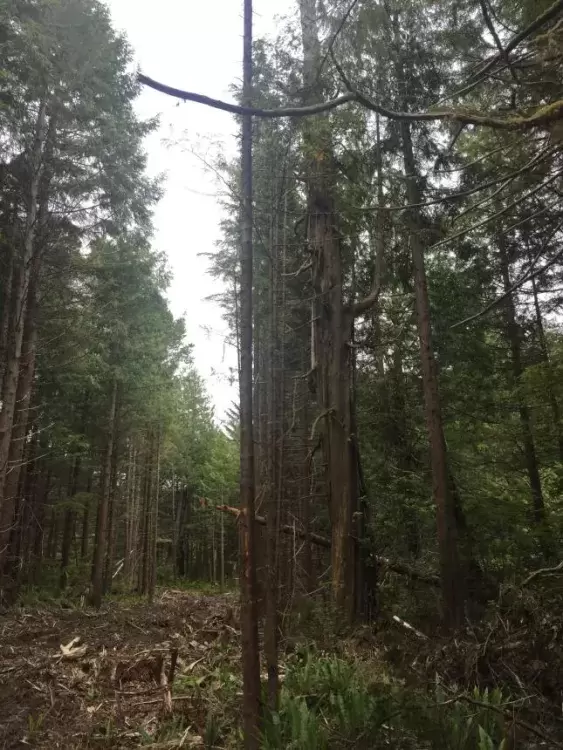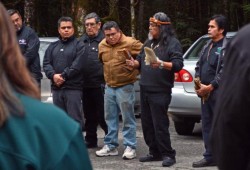Parks Canada is moving forward on the next phase of a 25-kilometre multi-use trail in Pacific Rim National Park Reserve, in partnership with local First Nations.
The year-round trail will extend from the southern to the northern boundaries of the Long Beach Unit, in Tla-o-qui-aht and Ucluelet traditional territories. To date, a total of $17.7 million has been invested in the project, with a further $16.3 million to be spent on the construction. Tla-o-qui-aht Lands and Resources Manager Saya Masso said it has been an intensive effort to get all the pieces together.
“[The consultation process] came along quite suddenly, with the cash flow from Ottawa, which required, then, an aggressive consultation time frame,” Masso said. “There has been an aggressive schedule that we have pursued in order to obtain the funding.”
Park Superintendent Karen Haugen, who is a member of Huu-ay-aht First Nations, said construction would begin in 2018.
"This is a brand-new multi-use trail," Haugen said. "The engineering is about 95 to 97 per cent complete. We have a few areas we still have to review."
Haugen said the engineering is being performed by Public Services Procurement Canada, in consultation with Tla-o-qui-aht and Ucluelet First Nations.
"Tammy Dorward (Tla-o-qui-aht) is the First Nations liaison," Haugen said. "We are consulting not only on management of Pacific Rim National Park Reserve, but also to identify both short and long-term benefits for both nations.
"We also have had, for some time, an Elders Group that was established to provide us guidance and information – traditional and ecological – on the multi-use trail," she said.
The Elders Group has been tasked with selecting a Nuu-chah-nulth name for the trail itself and place names for some of the stops along the route.
"We have also implemented a traditional use/archaeological study. Wood from the trail-clearing has been available to both nations for use in their communities. And we are hiring members from each nation for the environmental monitoring."
That monitoring process will include the protection of culturally significant areas along the trail, as well as ephemeral ponds and amphibian habitat.
Prior to the commencement of the work, Tla-o-qui-aht members performed a blessing ceremony at the site. Masso said there is some political significance in that.
“The blessing ceremony is somewhat common for projects Tla-o-qui-aht is involved in,” he explained. “It doesn’t always happen in other areas in the municipality. I think it should, but I’m glad that we got to do one with Parks Canada for the commencement of the trail construction.”
When the development takes place on fee-simple lands and requires Tla-o-qui-aht consultation, a blessing ceremony is not always approved, Masso explained.
“But we are involved in this development, and in our culture, we are acknowledging what we are taking from the land, and asking that the trees give themselves for the trail development – and that they are giving themselves for a good purpose. There are people who will be using this [trail] and enjoying the forest, educating people about healthy ecosystems… acknowledging and telling the land why you are going to be impacting it.”
While this is a park trail, Haugen said the entire 25 kilometres would be “paved,” although the surface material has not been selected at this point.
"This is a multi-use trail, so you can ride your bike, or walk or run," Haugen said.
The engineered width of the trail structure will be five metres, with the actual walking surface just 3.2 metres, so it won't be a matter of wheeling in hot asphalt trucks, she explained. For that reason, an alternate surface will likely be chosen, to allow smaller equipment to be used.
While the final, detailed route has not been released thus far, the trail will connect with each of the existing day-use areas within the Long Beach Unit. That will allow visitors to plan appropriate-length rides and hikes, Haugen said.
"So if you want to go from Incinerator Rock to Comber's Beach (five to six kilometres), you'll be able to do that," Haugen said. "The idea of this route was to connect all these day-use areas. For example, you could go to the Wya Surf Shop, then hike to Wickanninish Beach."
Much of the trail will run parallel to Highway 4, but with a forested buffer zone to ensure safety and user enjoyment.
Haugen said Parks Canada is in the process of issuing a Request For Information on its tendering website to select contractors for the trail-building.
"That will help determine the capacity and availability of local First Nations to be involved directly with the construction of the trail, and will inform the potential creation of an Indigenous Benefits Plan as part of the construction contract for the project."
Masso said while he is not sure if there are Tla-o-qui-aht members with the sort of specialized equipment required for working on a narrow trail surface, the nation will make bids to take on a significant role in the building process, as well as the ongoing monitoring system.
“As far as construction opportunities, we are a ready labour pool, and we hope that with the First Nation requirement component, through the bidding process, that we will be able to participate in a meaningful manner,” Masso said.
Haugen said that, by any stretch, building a trail in a National Park Reserve is a complicated undertaking.
"At Parks Canada, we are committed to do so in a respectful and sustainable way that mitigates any potential impact on the environment or the wildlife in the Pacific Rim."
Following the recent meeting with Prime Minister Justin Trudeau, Nuu-chah-nulth leaders observed that, while Ottawa is giving off positive signals, "reconciliation" between Canada and its indigenous peoples would have to include taking on greater participation in the economy and in governance of the greater community.
But Masso said it is important not to dismiss Ottawa’s current charm campaign as “just words.” Words can be powerful, he said.
“‘Reconciliation,’ and words like that, have brought development to our table on more occasions. It has allowed us to have a role in some of the projects – in the planning, in mitigating the impact on the environment, the design of the trails, to do the archaeological surveying and monitoring. Words like ‘reconciliation’ have brought us to the table.”
Masso is quick to note that this does not mean that full reconciliation has been achieved.
“There is a lot more to full ‘reconciliation’ than environmental monitoring and a blessing ceremony for the trail,” he said.
Haugen said through projects like the Pacific Rim National Park Reserve Trail, Parks Canada is moving in that direction.
"Parks Canada works with more than 300 Indigenous communities across Canada, in various ways – conserving, restoring and presenting all of Canada's natural and cultural heritage," she said.
"We truly appreciate the enthusiasm and the cooperation we are receiving from Tla-o-qui-aht and Ucluelet First Nations, and we will continue to identify both long and short-term benefits deriving from the construction of this project."








